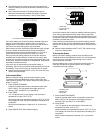
15
■ Trim excess fat to reduce spattering. Slit the remaining fat on
the edges to prevent curling.
■ Pull out oven rack to stop position before turning or removing
food. Use tongs to turn food to avoid the loss of juices. Very
thin cuts of fish, poultry or meat may not need to be turned.
■ After broiling, remove the pan from the oven when removing
the food. Drippings will bake on the pan if left in the heated
oven, making cleaning more difficult.
Broiling uses direct radiant heat to cook food. Use MAXI/ECONO
for broiling regular-sized and smaller cuts of meat, poultry and
fish. MAXI Broil uses both top elements for maximum browning
coverage of foods. Broil Econo uses the inner element for
browning coverage only in the center of foods.
Before broiling, position rack according to Broiling chart. It is not
necessary to preheat the oven before putting food in unless
recommended in the recipe. Position food on grid in the broiler
pan, then place it in the center of the oven rack. Close the door to
the broil stop position to ensure proper broiling temperature.
To Broil:
1. Press BROIL.
On some models, press once for Broil Maxi and twice for
Broil Econo.
2. Press START.
3. Press CANCEL OFF when finished.
Variable Temperature Broiling (on some models)
Changing the temperature when Variable Temperature Broiling
allows more precise control when cooking. The lower the
temperature, the slower the cooking. Thicker cuts and unevenly
shaped pieces of meat, fish and poultry may cook better at lower
broiling temperatures.
To Vari Broil:
1. Press BROIL.
On some models, press once for Broil Maxi and twice for
Broil Econo.
2. Press the number pads to set a temperature between 170°F
to 325°F (77°C to 163°C).
3. Press START.
The temperature can be changed after this step. START does
not need to be pressed again.
4. Press CANCEL/OFF when finished.
Broiling chart
For best results, place food 3 in. (7 cm) or more from the broil
element. Times are guidelines only and may need to be adjusted
for individual tastes. Recommended rack positions are numbered
from the bottom (1) to the top (5). For diagram, see the
“Positioning Racks and Bakeware” section.
Convection Cooking
In a convection oven, the fan-circulated hot air continually
distributes heat more evenly than the natural movement of air in a
standard thermal oven. This movement of hot air maintains a
consistent temperature throughout the oven, cooking foods more
evenly, crisping surfaces while sealing in moisture and yielding
crustier breads.
Most foods can be cooked by lowering cooking temperatures
25°F to 50°F (-3°C to 10°C) and cooking time can be shortened
by as much as 30 percent, especially for large turkeys and roasts.
■ It is important not to cover foods so that surface areas remain
exposed to the circulating air, allowing browning and crisping.
■ Keep heat loss to a minimum by only opening the oven door
when necessary.
■ Choose cookie sheets without sides and roasting pans with
lower sides to allow air to move freely around the food.
FOOD
RACK
POSITION TEMP
TOTAL
TIME
MIN.
Steak
1 in. (2.5 cm) thick
medium rare
medium
well done
4
4
4
500°F
(260°C)
16
21
25
Steak
1¹⁄₂ in. (3.8 cm) thick
rare
medium
4
4
500°F
(260°C)
23
28
*Ground meat patties
³⁄₄ in. (2 cm) thick
well done 5
500°F
(260°C) 8-12
Pork chops
1 in. (2.5 cm) thick 4 450°F
(232°C)
25-28
Ham slice [precooked]
¹₂ in. (1.25 cm) thick
1 in. (2.5 cm) thick
4
4
500°F
(260°C)
10-12
20-22
Frankfurters 4 500°F
(260°C)
8
Lamb chops
1 in. (2.5 cm) thick 4
400°F
(204°C) 18-20
Chicken
bone-in pieces 3
500°F
(260°C) 32
Fish
1/2 in. (1.25 cm) thick
1 in. (2.5 cm) thick
3
3
350°F
(177°C)
20
20-22
* Place up to 9 patties, equally spaced, on broiler grid.


















